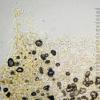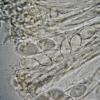
24-12-2025 17:08
Hulda Caroline HolteHello, I have found this propoloid ascomycete on

21-12-2025 09:32
Hello.A tiny ascomycete found embedded in wood in

21-12-2025 21:32
Pol DebaenstHello, Garden, Burgweg 19, Veurne, BelgiumOn 10/1

22-12-2025 23:38
Patrice TANCHAUDBonsoir, récolte sur un mur en pierre, apothéci

22-12-2025 00:47
Patrice TANCHAUDBonsoir, récolte à proximité du milieu dunaire
Asco from California, USA
Alan Rockefeller,
03-03-2017 11:58
 What is this? Under Quercus agrifolia in Oakland. Size approx 2 - 3 cm diameter.
What is this? Under Quercus agrifolia in Oakland. Size approx 2 - 3 cm diameter.Spores smooth, inamyloid, 18 × 10 micrometers. Asci inamyloid and with a rounded apex. Micrographs in Meltzer's.
Viktorie Halasu,
03-03-2017 23:21

Re : Asco from California, USA
Hello,
that's an interesting discomycete. That stipe reminds me of Tarzetta, but if the spores really are without guttules, then my best guess is a Geopyxis. If you can check the ascus base, Tarzetta has simple septate base, Geopyxis has forked (pleurorhynchous) base.
Viktorie
that's an interesting discomycete. That stipe reminds me of Tarzetta, but if the spores really are without guttules, then my best guess is a Geopyxis. If you can check the ascus base, Tarzetta has simple septate base, Geopyxis has forked (pleurorhynchous) base.
Viktorie
Nicolas VAN VOOREN,
10-03-2017 00:02

Re : Asco from California, USA
Tarzetta species possess large guttules in their spores.
Consider also the genus Jafnea (especially J. semitosta) because your micrographs show immature ascospores, but the spore shape agrees.
Consider also the genus Jafnea (especially J. semitosta) because your micrographs show immature ascospores, but the spore shape agrees.


